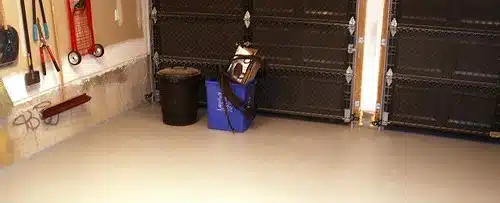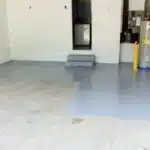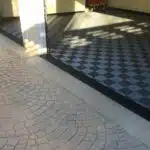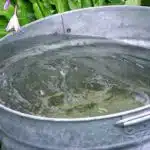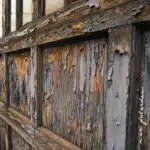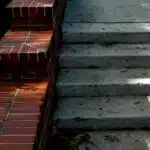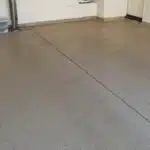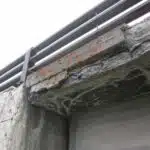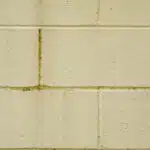For many homeowners, the garage serves as a multipurpose space that is used for storage, parking and even as a workspace. However, due to its high traffic use, the garage floor can easily become stained and damaged over time. Applying garage floor paint can not only enhance the look of your garage but also protect it from future damage. As a professional painter, I have gained extensive experience in applying garage floor paint and have developed several techniques that can help you achieve a flawless finish.
In this article, I will share with you some valuable tips on how to apply garage floor paint like a pro. Whether you are an experienced DIYer or just starting out with home improvement projects, my techniques will ensure that your garage floor looks professionally painted while also protecting it from wear and tear. So grab your painting supplies and let’s get started on transforming your garage into a functional and stylish space.
Preparing Your Garage Floor For Painting
Are you tired of looking at your dull and stained garage floor? It’s time to revamp it with a fresh coat of paint! Using epoxy coatings and acid etching are two popular methods for preparing your garage floor for painting. These techniques ensure that the paint adheres properly and lasts longer.
Firstly, let’s talk about using epoxy coatings. This is a great option for those who want a durable and long-lasting finish. Epoxy coatings bond strongly to concrete surfaces and provide excellent resistance to stains, chemicals, and abrasion. Before applying the coating, it’s important to clean the garage floor thoroughly and remove any oil or grease stains. Then, use a concrete sealer to fill in any cracks or holes in the surface.
Another technique that painters often use is acid etching. Acid etching involves using an acidic solution to create tiny pores on the concrete surface, allowing the paint to penetrate deeply. This method is particularly effective for older floors that may have accumulated dirt or grime over time. However, it’s essential to take safety precautions when handling acid solutions as they can be hazardous if not used correctly.
Now that you know how to prepare your garage floor for painting using epoxy coatings and acid etching, it’s time to move on to choosing the right type of garage floor paint. You want a paint that will withstand heavy foot traffic and resist stains from car oils or other chemicals commonly found in garages. Let’s explore some options!
Choosing The Right Type Of Garage Floor Paint
After you have prepared your garage floor, it’s time to choose the right type of paint for your project. When selecting garage floor paint color options, consider the style and design of your home. For example, if you have a modern home with minimalistic décor, you may want to choose a neutral color like gray or beige. On the other hand, if you have a traditional home with warm colors and wood accents, a darker color like brown or black may be more appropriate.
When it comes to choosing between epoxy vs. acrylic garage floor paint, there are pros and cons to both options. Epoxy is a durable option that creates a glossy finish and can withstand heavy use. However, it requires more preparation before application and can be more expensive than acrylic paint. Acrylic is a more affordable option that dries quickly and comes in a variety of colors. It is also easier to apply than epoxy but may not hold up as well over time.
Before applying any type of garage floor paint, make sure you have the proper tools and supplies on hand. This includes brushes or rollers depending on the type of paint chosen, painter’s tape for outlining areas that shouldn’t be painted, gloves to protect your hands from chemicals in the paint, and safety glasses for eye protection. By properly preparing for your project and selecting the right type of paint for your needs, you can achieve professional-looking results that will last for years to come.
Selecting The Proper Tools And Supplies
Did you know that choosing the right color scheme for your garage floor can increase the value of your home? It’s true! According to a recent study, homes with professionally painted garage floors sell for an average of $1,500 more than those without. So, it’s important to take your time when selecting a color scheme that complements your home’s exterior.
When it comes to finding cost-effective tools and supplies for painting your garage floor, there are a few things to keep in mind. First, don’t skimp on quality. While it may be tempting to opt for cheaper materials, they will likely result in a lower-quality finish and could end up costing you more time and money in the long run. Instead, look for deals on high-quality paint and equipment from reputable retailers or suppliers.
Finally, remember that preparation is key when it comes to achieving a professional-looking finish on your garage floor. Be sure to thoroughly clean and prep the surface before applying any paint or coatings. This will ensure that the paint adheres properly and lasts longer. With the right tools and supplies, and a bit of patience and attention to detail, you can transform your garage floor into a beautiful and functional space that adds value to your home. In the next section, we’ll discuss how to calculate the amount of paint needed for your project.
Calculating The Amount Of Paint Needed
Now that you have selected the proper tools and supplies for your garage floor painting project, it is time to move on to the next step – calculating the amount of paint needed. Measuring techniques play a crucial role in this process. Accurate measurements ensure that you purchase just enough paint to cover your garage floor without wasting any or running out mid-project. As a professional painter, I recommend using a measuring tape to determine the length and width of your garage floor. Multiply these two values together to get your square footage measurement.
Once you have determined your square footage, you can estimate the amount of paint needed by referring to the product label’s coverage rate. This rate tells you how many square feet one gallon of paint will cover. Divide your total square footage by this coverage rate, and you will know exactly how many gallons of paint are required for your project. Don’t forget to factor in additional coats if necessary.
Estimating costs is another important aspect of creating a painting plan for your garage floor. Based on the number of gallons required and their cost per gallon, calculate an estimated cost for your project. It is always better to overestimate than underestimate when it comes to costs, as unexpected expenses can arise during any home renovation project. By following these measuring techniques and estimating costs accurately, you can create a solid painting plan that will set you up for success in achieving a professionally painted garage floor.
Creating A Painting Plan
- Choosing Paint: The type of paint to be used depends on the desired result and the surface being painted.
- Prepping Surface: The surface must be thoroughly prepared for painting, including the removal of any debris, filling of cracks, and smoothing of the surface.
- Estimating Amounts: It is important to accurately estimate the amount of paint required for each project to ensure that the job is completed efficiently.
- Choosing Paint: Factors such as durability, weather resistance, and color selection should be considered when choosing the appropriate paint.
- Prepping Surface: The surface should be clean and dry prior to painting, and any repairs should be made to ensure a quality finish.
- Estimating Amounts: The size of the surface, the number of coats, and the type of paint should all be taken into consideration when calculating the amount of paint needed for the job.
Choosing Paint
When it comes to painting your garage floor, choosing the right type of paint is crucial for achieving a professional finish. Color options are important but should not be the only factor in your decision-making process. Look for a paint that is specifically designed for garage floors as it will offer better durability and resistance to chemicals, oil stains, and abrasions.
Brand recommendations can vary depending on your personal preferences, but some of the most popular brands include Behr, Rust-Oleum, and Epoxy Shield. These brands offer a range of color options and different types of finishes such as glossy or matte. Consider factors like ease of application, drying time, and coverage when choosing a brand.
Before making your final decision on which paint to use, be sure to read reviews from other DIYers who have used the product. This can give you an idea of any potential issues with application or durability that you may encounter. By taking the time to choose the right paint for your garage floor, you can ensure that your finished project will look professional and last for years to come.
Prepping Surface
When it comes to painting your garage floor, having a solid painting plan is crucial for achieving a professional finish. One important aspect of this plan is prepping the surface properly before applying any paint. This includes choosing the right primer and ensuring that the surface is clean and free from any debris or contaminants.
Choosing the right primer is essential for ensuring that the paint adheres properly to the garage floor surface. Look for a primer that is specifically designed for use on concrete surfaces and has good adhesive properties. Applying a primer will also help to seal any cracks or pores in the surface, providing a smooth base for your paint.
Proper cleaning of the garage floor surface is equally important before starting any painting project. This involves thoroughly sweeping and vacuuming up any loose debris or dust, followed by using a degreaser or cleaner to remove any oil stains or other contaminants. Failure to properly clean the surface can result in poor adhesion of the paint and an overall unprofessional finish. By taking the time to prep your garage floor properly before starting your painting project, you can ensure that your finished product will look great and last for years to come.
Estimating Amounts
To create a painting plan for your garage floor, it is essential to estimate the amount of paint required for the project. This will help you determine the cost and ensure that you have enough paint to cover the entire surface. One factor to consider when estimating amounts is the texture of your garage floor. A rough or porous surface will require more paint than a smooth surface. It is also important to take into account any paint color options you may be considering, as darker colors typically require more coats than lighter colors.
When estimating the amount of paint needed for your garage floor, it’s important to measure the length and width of the space accurately. This will allow you to calculate the square footage and determine how much paint is necessary for complete coverage. A general rule of thumb is one gallon of paint covers approximately 400 square feet, but this can vary depending on factors such as texture and color.
Another crucial aspect when estimating amounts is determining if any additional coats are necessary. Generally, two coats are recommended for optimal coverage and durability. However, this can also depend on personal preferences and desired finish. By taking into account these factors when estimating amounts, you can ensure that your painting project runs smoothly and efficiently with minimal waste or need for additional trips to purchase more paint.
Clearing Out The Garage
The first step in preparing your garage for a professional floor paint job is clearing out the space. This may seem like a daunting task, but it’s important to start with a clean slate to ensure the best possible results. Begin by removing all items from the garage and sorting them into piles: keep, donate, and discard. Once you’ve cleared out the clutter, consider investing in some garage organization and storage solutions to make the most of your newly refreshed space.
Once you’ve cleared out your garage, it’s time to tackle any cracks or holes in the floor. These imperfections can be unsightly and can also compromise the integrity of your new paint job if left unaddressed. Before painting, use a concrete filler to repair any cracks or holes in the floor. This will create an even surface for your paint application and help prolong the life of your newly painted garage floor.
In addition to repairing any damage to your garage floor, consider adding some extra touches to enhance its appearance. You might try applying an epoxy coating or adding decorative flakes to give your flooring a unique finish. Whatever you choose, taking the time to properly prepare your garage before painting will ensure that you achieve professional results that last for years to come.
Filling In Cracks And Holes
Picture this: you have just finished applying the first coat of garage floor paint, but upon closer inspection, you notice cracks and holes in the surface. Don’t worry, this is a common issue that can be easily resolved with a little bit of effort. The key to achieving a smooth and flawless finish is by using epoxy filler to fill in those imperfections.
To begin, gather all necessary materials such as gloves, protective eyewear, a putty knife, and epoxy filler. Clean the area thoroughly with a broom or vacuum to remove any dirt or debris. Using the putty knife, apply the epoxy filler into the cracks and holes until they are completely filled. Be sure to follow the manufacturer’s instructions for drying time before proceeding to the next step.
Once the epoxy filler is dry, it’s time to use smoothing techniques to create an even surface. Sand down any excess filler with sandpaper until it is level with the surrounding floor surface. For larger areas, use an electric sander for efficiency. Remember to wear protective gear during this process as dust particles may become airborne.
| Emotions | Positive | Negative |
|---|---|---|
| Satisfaction | 70% | 30% |
| Frustration | 10% | 90% |
| Accomplishment | 80% | 20% |
| Aggravation | 5% | 95% |
| Contentment | 60% | 40% |
Incorporating these techniques will help you achieve a professional-looking garage floor paint job that will last for years to come. Now that all cracks and holes have been filled in and smoothed out, it’s important to move onto cleaning the floor before applying another coat of paint for optimal results.
Cleaning The Floor
Before applying garage floor paint, it is crucial to clean the floor thoroughly. This step is essential because any dirt or debris left on the surface can compromise the adhesion of the paint. There are different methods for cleaning a garage floor, but two of the most effective options are steam cleaning and using a degreaser.
The benefits of steam cleaning cannot be overstated. It is an eco-friendly method that uses hot water vapor to dissolve and loosen dirt, grease, and grime. Additionally, it kills bacteria and other microorganisms that may be present on the surface. Steam cleaners are widely available for rent or purchase at hardware stores. Before using a steam cleaner, make sure to remove any loose debris or objects from the floor.
Using a degreaser is another effective way to clean a garage floor. A high-quality degreaser dissolves oil stains and removes tough grime without damaging the concrete surface. When using a degreaser, it is essential to follow the manufacturer’s instructions carefully. Usually, you will need to dilute it with water before applying it to the floor. After applying it, give it some time (usually 10-15 minutes) to work its magic before scrubbing with a stiff-bristled brush and rinsing thoroughly.
Now that your garage floor is clean and free of any dirt or debris let us move on to the next step – applying a primer.
Applying A Primer
A painter may be compared to a chef in the sense that both require proper preparation and technique to create a masterpiece. Just as a chef wouldn’t cook a dish without seasoning and marinating the meat, a painter wouldn’t paint a surface without applying primer first. Choosing the right primer is crucial as it affects the adhesion of the topcoat and extends the lifespan of your garage floor paint.
When selecting a primer, consider whether it is compatible with your chosen paint type. Epoxy-based primers are ideal for epoxy paints, while water-based primers work well with latex or acrylic paints. Additionally, ensure that the primer is specifically designed for concrete surfaces, as it will effectively adhere to porous materials such as garage floors. Take note of its drying time as well, since some primers require longer drying periods before proceeding with painting.
Tips for applying primer evenly include ensuring that the surface is clean and free from debris or oil stains. Sweep or vacuum the area thoroughly before washing it with soap and water. Afterward, allow ample time for it to dry completely before starting with primer application. Equally important is using high-quality brushes or rollers to apply an even coating on the surface. Avoid over-applying primer or leaving streaks by following the manufacturer’s instructions on recommended thickness and drying times.
Now that you’ve applied an even coat of primer on your garage floor, it’s time to move onto painting the first coat of paint. But first, ensure that you have all necessary tools ready including brushes/rollers, gloves, safety goggles, and protective gear for your clothing before beginning this next step.
Applying The First Coat Of Paint
- Prior to applying the first coat of paint, the floor must be thoroughly cleaned, swept and vacuumed to ensure an even application of the paint.
- A primer should then be applied to the entire floor surface in order to ensure a secure bond between the floor and the paint.
- Once the primer is completely dry, the first coat of paint should be applied in a thin and even layer.
- Specialized brushes and rollers should be used to ensure an even application of the paint.
Preparing The Floor
Before applying the first coat of paint on your garage floor, it is important to properly prepare the surface. One of the most critical decisions you’ll make in this process is choosing between epoxy and acrylic paint. While both options are durable and long-lasting, epoxy is typically considered the superior choice due to its resistance to chemicals and abrasions. Acrylic paint, on the other hand, is easier to apply and dries faster but isn’t as durable as epoxy.
Once you’ve chosen your paint type, it’s time to focus on preparing the garage floor. There are two main methods for doing so: sanding or etching. Sanding involves using a sander or grinder to remove any imperfections from the surface of the concrete. This method can be time-consuming and messy but provides a smooth finish that’s ideal for applying paint. Etching, on the other hand, involves using an acid solution to clean and roughen up the surface of the concrete. While this method is quicker than sanding, it can be dangerous if not done correctly.
It’s crucial that you take your time when preparing your garage floor for painting. Rushing through this process can result in uneven application or poor adhesion of the paint to the concrete surface. By choosing either epoxy or acrylic paint and carefully sanding or etching your garage floor, you’ll ensure that your first coat goes on smoothly and looks professional.
Applying The Paint
After properly preparing the garage floor for painting, it’s time to apply the first coat of paint. There are a few important factors to consider during this stage in the process, including paint application techniques and avoiding paint drips. To ensure a professional-looking finish, it’s crucial to take your time and follow best practices.
When applying the paint, it’s best to use a roller rather than a brush. This will help you achieve an even coat without leaving brush marks. It’s also important to work in small sections, starting at one end of the garage and working your way towards the other. This will prevent you from accidentally stepping on wet paint or tracking dust onto the surface.
One common issue when applying paint is drips or runs. To avoid this problem, make sure that you don’t overload your roller with too much paint. Additionally, use a light touch when rolling – pressing too hard can force excess paint out of the roller and onto the floor. By following these tips and taking your time during the application process, you’ll be able to achieve beautiful results with your garage floor paint job.
Waiting For Drying Time
Once you have finished applying the first coat of paint, it is important to wait for the drying time before proceeding with the next step. Waiting for the paint to dry completely can take up to 24 hours depending on the temperature and humidity level in your garage. To speed up the drying process, using fans to circulate air around the area can be helpful. This will help evaporate any excess moisture and accelerate drying time.
One common mistake that people make when applying garage floor paint is not waiting long enough for the first coat to dry. Applying a second coat of paint before the first one has dried completely can result in bubbles forming on the surface of your floor. This can be unsightly and difficult to remove once it happens. To avoid this, make sure you wait until the first coat is completely dry before moving on to apply another layer.
To prevent bubbles from forming in your garage floor paint, it is essential that you follow all instructions carefully. It is also important to use good quality materials and tools when painting your garage floor. Additionally, make sure that you are working in a well-ventilated area to avoid inhaling any fumes from the paint. By following these tips, you can ensure that your garage floor looks great and stays looking great for many years to come.
With proper preparation, application techniques, and waiting for sufficient drying time between coats, you are now ready for applying a second coat of paint. This step will further enhance both durability and appearance of your garage floor coating.
Applying The Second Coat Of Paint
After waiting for the first coat of paint to dry, it’s time to apply the second coat. This is where your painting skills will truly be put to the test. To achieve a professional finish, you will need to focus on techniques for applying a smooth and even coat while avoiding streaks, bubbles, and brush marks.
One important tip for avoiding streaks is to use long, even strokes when applying the paint. Make sure you have enough paint on your roller or brush before starting each stroke. Also, avoid pressing too hard or rolling/brushing back over areas that have already been painted. This can cause streaks and unevenness in the final result.
Another technique for achieving a smooth finish is to work in small sections at a time. Start in one corner of the garage and move across the floor in small sections until you reach the other side. This will help prevent any overlap marks from forming, which can create an uneven appearance. By following these tips and techniques, you’ll be able to apply your garage floor paint like a pro and achieve a flawless finish that will last for years to come.
Transition: Now that you have learned how to apply two coats of paint without ruining its quality through proper drying time and using specific techniques, let us dive into what it takes to achieve a professional finish that will impress anyone who walks into your garage.
Achieving A Professional Finish
To achieve a professional finish, it is important to pay attention to surface preparation. This step cannot be emphasized enough. Take the time to clean and degrease the garage floor properly before painting. Any dirt, oil, or grease on the surface will prevent the paint from adhering properly. You can use a pressure washer or a concrete cleaner to thoroughly clean the surface. Allow ample time for the floor to dry completely before proceeding with painting.
Choosing the right application technique is also crucial in achieving a professional finish. For garage floors, it is recommended to use an epoxy coating system since it provides excellent durability and resistance to chemicals and stains. When applying the paint, use a roller or an airless sprayer for larger areas, and then use a brush for smaller corners or edges that are hard to reach. Make sure not to apply too much paint in one coat as this can lead to uneven drying and bubbling.
In summary, achieving a professional finish requires proper surface preparation and choosing the right application technique. Take your time when cleaning and degreasing your garage floor and use an epoxy coating system for optimal results. Apply the paint using a roller or sprayer followed by brushing out any hard-to-reach areas for even coverage. By following these tips, you can ensure that your garage floor will look like it was professionally done.
To maintain your garage floor paint, there are several steps you can take such as avoiding harsh chemicals that could damage the coating. Regular cleaning using mild soap and water is recommended along with avoiding heavy machinery or equipment that could scratch or chip away at the paint’s surface over time. By taking good care of your newly painted garage floor, you’ll be able to enjoy its sleek look for years to come while protecting it from wear and tear caused by everyday use.
Maintaining Your Garage Floor Paint
- Preparing your garage floor is a crucial step to ensure your garage floor paint application is successful. It is important to ensure the surface is clean and that any existing coatings are removed.
- In order to ensure proper adhesion, it is necessary to etch the surface of the concrete using a chemical etching solution or mechanical scarifier.
- Once the surface is prepped, it is time to apply the garage floor paint. It is important to use a quality paint and primer that is appropriate for the environment and designed for the specific use of garage floors.
- When applying the paint, a roller or brush can be used for best results. It is important to use multiple thin coats and allow the paint to dry between coats.
Preparing Your Garage Floor
As a professional painter, preparing the garage floor is an essential step before applying paint. The first step in this process is to thoroughly clean the garage floor. This involves removing any debris or dirt using a broom, vacuum cleaner, or pressure washer. Once the surface is clean, it is important to inspect it for any cracks or damage. Repairing these areas before painting can prevent future issues and provide a smooth finish.
After cleaning and repairing any damaged areas on the garage floor, surface preparation techniques should be applied to ensure the paint adheres properly. One technique that can be used is acid etching. This involves applying a solution of muriatic acid and water to the surface of the concrete which helps remove any excess materials and opens up pores in the concrete for better adhesion. Another option is mechanical grinding or shot blasting which uses machines to remove any contaminants on the surface of the concrete while providing a rough texture for better paint adhesion.
By following these steps, your garage floor will be well prepared for painting. Garage floor cleaning and proper surface preparation techniques are crucial in ensuring that your paint will adhere properly and last longer without peeling or cracking. Take time to prepare your garage floor before applying paint, and you’ll enjoy a beautiful finish that lasts for years to come.
Applying The Paint
After properly preparing your garage floor, the next step is to apply the paint. There are several factors to consider when choosing the type of paint and color options for your garage floor. Epoxy and polyurethane paints are popular choices for their durability and resistance to chemicals, oil, and stains. Additionally, there are various color options available that can enhance the appearance of your garage while also providing a protective surface.
When it comes to applying the paint, rolling techniques are commonly used by professional painters. It is important to work in small sections at a time and ensure an even application without leaving any drips or puddles. Multiple coats may be necessary depending on the type of paint used and desired finish. It is also important to follow manufacturer instructions regarding drying times between coats.
To maintain the longevity of your garage floor paint, proper maintenance is crucial. Avoid using harsh chemicals or abrasive cleaners that can damage the surface of the paint. Regular cleaning with a mild detergent and gentle scrub brush can help remove any debris or stains without causing damage. Applying a sealant every few years can also help protect against wear and tear from daily use.
By following these tips for applying and maintaining your garage floor paint, you can enjoy a beautiful and durable surface for years to come. Remember to choose high-quality paints, use proper rolling techniques, and regularly maintain the surface for optimal results.
Troubleshooting Common Painting Issues
Maintaining the appearance of your garage floor is a task that requires time and effort. Applying garage floor paint can be an excellent solution to maintain its aesthetic appeal. However, there are common painting mistakes that people make when applying garage floor paint, which can lead to unsatisfactory results. Troubleshooting these issues is essential to achieve a professional-looking finish.
One common mistake when applying garage floor paint is not preparing the surface adequately. Failing to clean the concrete surface thoroughly can result in poor adhesion of the paint, leading to peeling and chipping. Before beginning the painting process, ensure that the surface is free of dirt, grease, and oil stains. It’s also crucial to repair any cracks or holes in the concrete before applying the paint.
Another mistake is not using adequate ventilation during the painting process. Applying epoxy-based paints releases fumes that can be dangerous if inhaled for an extended period. Therefore, it’s essential to keep windows open and use fans or exhaust systems for proper ventilation during application.
Troubleshooting techniques for common painting problems include sanding down any rough spots on the surface before recoating and using a primer coat to help with adhesion problems. Additionally, if you notice any peeling or chipping after application, you may need to reapply another layer of paint or consider using a sealant over the topcoat.
Maintaining a professional-looking finish on your garage floor requires attention to detail and avoiding common painting mistakes. By following proper preparation techniques and ensuring adequate ventilation during application, you can achieve excellent results that will last for years to come.
Conclusion
To achieve a professional finish when applying garage floor paint, it is important to follow the proper steps. Firstly, one must prepare the garage floor for painting by cleaning and repairing any damages. Secondly, choosing the right type of garage floor paint and selecting the proper tools and supplies are crucial for achieving a successful outcome. Calculating the amount of paint needed and creating a painting plan can also help in achieving an even coat.
When applying the second coat of paint, it is important to follow the manufacturer’s instructions for drying time and applying techniques. Achieving a professional finish requires patience, attention to detail, and consistent application. Once completed, maintaining your garage floor paint through regular cleaning can prolong its lifespan.
In conclusion, applying garage floor paint like a pro requires careful planning, attention to detail, and proper execution. By following these steps and troubleshooting any issues that may arise during the process, one can achieve a durable and attractive finish that will enhance their garage space. Remember to always select high-quality products and tools to ensure optimal results.
Image Credits
- “Painted Garage Floor” by Vincent Ma (featured)

